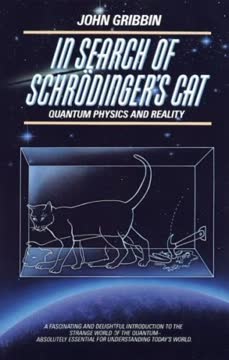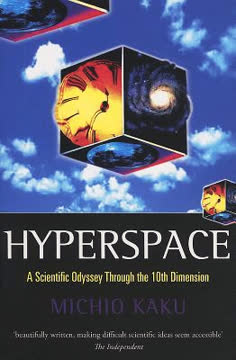Key Takeaways
1. The boundaries of impossibility are constantly shifting with scientific progress
"If at first an idea does not sound absurd, then there is no hope for it."
Scientific revolutions redefine impossibility. Throughout history, ideas once thought impossible have become reality through scientific breakthroughs. The Wright brothers' flight, space travel, and quantum mechanics were all once deemed absurd. Today's impossibilities may become tomorrow's technologies.
Classification of impossibilities:
- Class I: Currently impossible but potentially achievable within this century
- Class II: Violate known laws of physics but may be possible in distant future
- Class III: Fundamentally impossible or require complete revision of physical laws
Progress often comes from challenging established beliefs and exploring the boundaries of what's possible. As our understanding of the universe expands, so does our ability to manipulate its laws and achieve the seemingly impossible.
2. Force fields and invisibility: From science fiction to emerging reality
"You cannot depend on your eyes when your imagination is out of focus."
Force fields may become possible through advancements in plasma technology and superconductors. While not yet practical for large-scale applications, researchers are developing "plasma windows" that can separate environments and "magnetic bottles" to contain high-energy particles.
Invisibility is moving from fiction to reality through:
- Metamaterials: Engineered to bend light around objects
- Adaptive camouflage: Real-time mimicking of surroundings
- Active cancellation: Projecting inverted light patterns
These technologies, while still in early stages, show promise for military, scientific, and commercial applications. As our understanding of light manipulation improves, true invisibility may become achievable within decades.
3. Phasers and antimatter: Harnessing the power of subatomic particles
"Antimatter exists because the Dirac equation has two types of solutions, one for matter, and one for antimatter."
Phasers and directed energy weapons are becoming reality through advances in laser technology. High-powered lasers are already used in industrial and military applications, with ongoing research into more compact and powerful systems.
Antimatter, while incredibly expensive to produce, holds immense potential:
- Most powerful known form of energy
- Potential fuel for interstellar travel
- Key to understanding fundamental physics
Current antimatter production is minuscule, but future breakthroughs could unlock its potential for energy generation and propulsion. The challenge lies in efficiently producing and containing antimatter, as well as harnessing its power safely.
4. Teleportation: Quantum entanglement opens new possibilities
"To me, it was just incredible because you could see brain cells changing their activity. Then I knew that everything could go forward, that the technology would actually work."
Quantum teleportation of information is now a reality, though teleporting macroscopic objects remains a distant goal. Scientists have successfully teleported photons and even small atoms using quantum entanglement.
Key developments in teleportation:
- Quantum entanglement of particles over long distances
- Teleportation of quantum states between atoms
- Progress in quantum computing and communication
While Star Trek-style human teleportation is still firmly in the realm of science fiction, quantum teleportation is revolutionizing secure communication and quantum computing. Future advances may allow for teleportation of larger systems and more complex information.
5. Telepathy and psychokinesis: Mind over matter remains elusive
"You cannot depend on your eyes when your imagination is out of focus."
Telepathy and psychokinesis remain unproven despite decades of research. While some studies suggest subtle effects, no conclusive evidence supports these phenomena. However, brain-computer interfaces are making significant progress in translating thoughts into actions.
Advancements in brain-machine interfaces:
- Direct neural control of prosthetics
- Thought-to-text communication for paralyzed individuals
- Brain-to-brain communication through technological intermediaries
While true telepathy may be impossible, technology is bridging the gap between thought and action in ways that may eventually approximate mind-to-mind communication and control of objects through neural signals.
6. Robots and artificial intelligence: The quest for conscious machines
"Someday in the next thirty years, very quietly one day we will cease to be the brightest things on Earth."
Artificial Intelligence is rapidly advancing, with machines now capable of complex tasks and decision-making. However, true artificial consciousness remains elusive and philosophically contentious.
Key areas of AI development:
- Machine learning and neural networks
- Natural language processing
- Computer vision and pattern recognition
- Robotics and autonomous systems
While AI systems continue to improve, creating machines with human-like general intelligence and self-awareness presents immense challenges. The nature of consciousness itself remains poorly understood, making it difficult to replicate artificially.
7. Extraterrestrial life: The search for cosmic companions
"Either we are alone in the universe, or we are not. Either thought is frightening."
The search for extraterrestrial life has intensified with advances in astronomy and planetary science. While no conclusive evidence has been found, the discovery of exoplanets and potential biosignatures keeps hope alive.
Key areas of research:
- Exoplanet detection and characterization
- Analysis of biosignatures in planetary atmospheres
- Search for technosignatures (SETI)
- Exploration of potentially habitable worlds in our solar system
As our ability to detect and analyze distant worlds improves, the chances of discovering extraterrestrial life increase. However, the vastness of space and the potential rarity of life make this a challenging endeavor.
8. Faster-than-light travel: Wormholes and warping spacetime
"Nothing is more probable," said the Professor..."I wonder what they do teach them at these schools."
Faster-than-light travel, while seemingly impossible under Einstein's theory of relativity, may have loopholes. Theoretical concepts like wormholes and the Alcubierre drive propose methods of circumventing the light-speed limit.
Potential FTL concepts:
- Wormholes: Shortcuts through spacetime
- Alcubierre drive: Warping space around a ship
- Tachyons: Hypothetical faster-than-light particles
These ideas remain highly speculative and face enormous technical and energy requirements. However, they illustrate how creative thinking can challenge even the most fundamental laws of physics.
9. Time travel: Theoretical possibilities and paradoxes
"If time travel is possible, then where are the tourists from the future?"
Time travel to the future is possible through relativistic effects, but travel to the past remains highly problematic. While some solutions to Einstein's equations allow for closed timelike curves, they face significant physical and logical obstacles.
Challenges of time travel:
- Grandfather paradox and logical inconsistencies
- Enormous energy requirements
- Violation of causality
While time travel to the past may be fundamentally impossible, exploring its theoretical possibilities has led to important insights in physics and our understanding of the nature of time itself.
10. Perpetual motion and precognition: The limits of physical laws
"In this house we obey the laws of thermodynamics!"
Perpetual motion machines and precognition represent fundamental impossibilities under our current understanding of physics. They violate core principles like conservation of energy and causality.
Reasons for impossibility:
- Violation of thermodynamic laws
- Conflict with causality and information theory
- No reproducible evidence despite centuries of attempts
While these concepts may be truly impossible, exploring their limits has led to important discoveries in physics and a deeper understanding of the fundamental laws governing our universe. The pursuit of the impossible often leads to unexpected breakthroughs in other areas of science and technology.
Last updated:
FAQ
What's Physics of the Impossible about?
- Exploration of Impossibilities: The book investigates technologies and concepts currently deemed impossible, such as teleportation, time travel, and telepathy, categorizing them based on their feasibility.
- Scientific Basis: Michio Kaku uses physics principles to analyze these concepts, providing a framework for understanding potential future technologies.
- Future Predictions: It speculates on technological advancements that could make the impossible possible, encouraging readers to consider the limits of human innovation.
Why should I read Physics of the Impossible?
- Engaging Perspective: Kaku presents complex scientific ideas in an accessible manner, making it suitable for both science enthusiasts and general readers.
- Inspiration for Innovation: The book encourages readers to explore the boundaries of current technology and the possibilities that lie ahead.
- Understanding Science Fiction: It provides a deeper understanding of the scientific principles behind popular science fiction concepts.
What are the key takeaways of Physics of the Impossible?
- Classification of Impossibilities: Kaku categorizes impossibilities into three classes based on their feasibility within known physics.
- Historical Context: The book illustrates how technologies once deemed impossible have become commonplace, showing the evolving nature of scientific understanding.
- Future Technologies: It discusses emerging technologies like quantum teleportation and advanced robotics, suggesting potential breakthroughs.
What are the best quotes from Physics of the Impossible and what do they mean?
- Einstein's Absurd Ideas: “If at first an idea does not sound absurd, then there is no hope for it.” This highlights the role of imagination in scientific discovery.
- Pushing Boundaries: “The only way of discovering the limits of the possible is to venture a little way past them into the impossible.” It emphasizes exploration and experimentation.
- Clarke's Magic Technology: “Any sufficiently advanced technology is indistinguishable from magic.” This reflects the transformative power of scientific advancement.
How does Michio Kaku classify impossibilities in Physics of the Impossible?
- Class I Impossibilities: Technologies that are impossible today but do not violate known physics, like teleportation and invisibility, potentially realizable within a century.
- Class II Impossibilities: Technologies that may be realized over millennia, such as time travel, requiring advancements in physics.
- Class III Impossibilities: Technologies that violate known physics laws, considered impossible under current understanding.
How does Physics of the Impossible relate science fiction to real science?
- Inspiration from Sci-Fi: Kaku notes how science fiction inspired many scientists, including himself, to pursue careers in science.
- Analyzing Sci-Fi Concepts: The book examines the scientific plausibility of science fiction technologies, bridging the gap between fiction and reality.
- Encouraging Imagination: Science fiction stimulates scientific inquiry and innovation by exploring the boundaries of possibility.
What scientific principles behind teleportation are discussed in Physics of the Impossible?
- Quantum Mechanics: Teleportation is rooted in quantum mechanics, allowing for the transfer of information without physical movement.
- Quantum Entanglement: Entanglement allows particles to remain connected regardless of distance, enabling information transfer.
- Current Research: Ongoing experiments in quantum teleportation have successfully teleported photons and atoms, though macroscopic teleportation remains far off.
What challenges does Kaku identify regarding telepathy in Physics of the Impossible?
- Scientific Limitations: Current technology can only provide vague outlines of thoughts, not precise details, due to the complexity of brain activity.
- Ethical Concerns: Mind-reading raises ethical questions about privacy and consent, requiring careful consideration of implications.
- Future Possibilities: Kaku remains optimistic about future advancements in neuroscience and technology, categorizing telepathy as a Class I impossibility.
How does Physics of the Impossible address the concept of force fields?
- Definition and Origin: Force fields are invisible barriers inspired by science fiction, traced back to Faraday’s work on electromagnetic fields.
- Scientific Challenges: Creating force fields poses significant challenges, as current forces do not allow for impenetrable barriers.
- Potential Solutions: Possible avenues include using plasmas or advanced materials, with force fields classified as a Class I impossibility.
What insights does Physics of the Impossible provide about the search for extraterrestrial life?
- Drake's Equation: Kaku discusses the equation estimating the number of civilizations in the galaxy, highlighting its framework and uncertainties.
- SETI Efforts: The book outlines the history and challenges of SETI, noting the lack of definitive signals despite decades of searching.
- Astrobiological Considerations: The importance of liquid water and carbon-based chemistry is emphasized, with recent discoveries suggesting promising prospects.
How does Kaku envision the future of robotics in Physics of the Impossible?
- Advancements in AI: Rapid advancements suggest machines may soon achieve intelligence comparable to animals, emphasizing AI research approaches.
- Ethical Implications: The potential for robots to surpass human intelligence raises ethical questions about their societal role.
- Future Possibilities: Kaku envisions robots with emotions and consciousness, categorizing their development as a Class I impossibility.
What is the significance of antimatter in Physics of the Impossible?
- Energy Potential: Antimatter could be an efficient energy source, releasing vast energy when interacting with matter, though production challenges exist.
- Space Exploration: Antimatter propulsion could enable faster space travel, requiring continued research for feasibility.
- Philosophical Questions: Antimatter raises questions about the universe's nature, including anti-universes and parallel realities, challenging our understanding.
Review Summary
Physics of the Impossible explores various sci-fi concepts, categorizing them into three levels of impossibility based on current scientific understanding. Kaku's optimistic approach and accessible writing style make complex physics concepts engaging for non-experts. Readers appreciate the book's references to pop culture and sci-fi, as well as its exploration of cutting-edge physics theories. While some find certain sections challenging or less interesting, most reviewers praise Kaku's ability to simplify complex ideas and inspire wonder about future technological possibilities.
Similar Books










Download PDF
Download EPUB
.epub digital book format is ideal for reading ebooks on phones, tablets, and e-readers.












